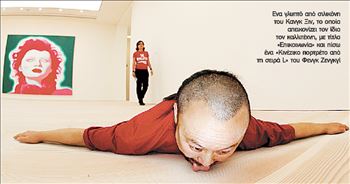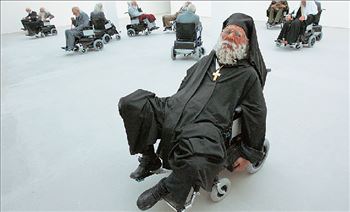Η εναρκτήρια έκθεση έχει τον πομπώδη τίτλο «Η επανάσταση συνεχίζεται» («Τhe revolution continues»). Λες και ακούς τρέιλερ σε μεγάλη κινηματογραφική έκθεση: «Και τώρα,


[ΤΟ ΒΗΜΑ, Πέμπτη, 9 Οκτωβρίου 2008]
© Τhe Τimes, 2008
Charles Saatchi is the Hollywood mogul of the Brit Art world. He is the player who can make it all happen. It was he who opened the floodgates of Cool Britannia; in the 1990s his name was a brand that could turn a student into a star overnight. His 1997 show Sensation was precisely that.
This week, after a three-year search for a site, a new Saatchi gallery opens to the public. The Duke of York’s HQ building in Chelsea, with its portentous façade and Neo-Classical trimmings, has been converted into a vast private gallery of contemporary art that could hardly be farther in mood from the Edwardian gloom of Saatchi’s previous County Hall premises.
All is light and white and pale wood. The visitor strolls through spacious top-lit galleries that are arranged over four floors. And though the occasional stairwell offers a view like some modern version of a Piranesi – a succession of apertures and archways and levels and railings – the architects seem self-effacing. This building, in Kings Road, is emphatically about the art it displays.
So, is Saatchi going to change the course of culture single-handedly again?
The opening show is called The Revolution Continues. You can almost hear the voiceover on the cinema trailer: “Now, from the man who brought you the Brit Pack [pause while an oriental gong reverberates]: New Art from China.”
This time Saatchi is playing catchup. At about the same time as he was producing Brit Art, China was planting its cultural flag in our consciousness. Now Saatchi jumps on the bandwagon. It feels a bit late.
China’s cultural makeover has been aggressively contemporary. There are plenty of works that suit the Saatchi brand. This is a collector who, above anything, understands the importance of instant impact. The fairground has never been far from his aesthetic.
Go down to the basement and see his latest dodgems. Old Persons Home is an installation by Sun Yuan and Peng Yu, whose queasy artistic experiments with cadavers and foetuses got them censored in the 1990s. Now, replicas of old people, decrepit and toothless, move slowly about in motorised wheelchairs. When you notice that they look suspiciously like political leaders, the whole piece becomes like some hellish parody of a United Nations conference, their encounters and entanglements going on for all eternity at a snail’s pace. This work – like the artists’ fallen angel upstairs – is cruel, disturbing, ruthless, frightening, satirical and horribly sad. But more often you are simply offered Sensation-style pieces with a Chinese twist. An enormous sculpture of a taxidermist’s donkey copulating with the emblematic Jin Mao tower goes to an awful lot of mechanical effort to make a simple point and then takes it no farther.
Here is the Chinese version of Ron Mueck’s huge hyper-real sculptures, or of the Chapman brothers’ scatologi-cal fascinations or Chuck Close’s pixellated images. They seem mere imitations, appealing to an existing market.
The occasional reference to traditional woodcuts or feng shui or Chairman Mao is not enough to lend authenticity. Mao crops up on anything from mock-ups of historical scenarios to a tin of Quaker Oats. But this was a man who erased or ruined the lives of millions. Poking fun hardly seems a real response. Mao’s successors still preside over China. They may see culture as the latest platform from which to assert themselves. We are seeing only what they permit us to see. This affectionate teasing of Mao feels like no more than a show of fake tolerance.
Surely Chinese history is more than a few press photos to be manipulated by painters. And a model city made of dog chews does not really address concerns about consumerism.
China is an extraordinary country. The Cultural Revolution created a virtual world in which a vast nation lived for years. The reality of unreality seems a highly contemporary concept. Yet the works that Saatchi offers seem for the most part – there were some exceptions such as Cang Xin’s record of his self-abasing performances – commercially unadventurous.
He is not setting a new course with this opening show. He is offering a slick fake with lots of funds thrown in. It is as if Merchant Ivory had tackled a martial arts movie.


No comments:
Post a Comment